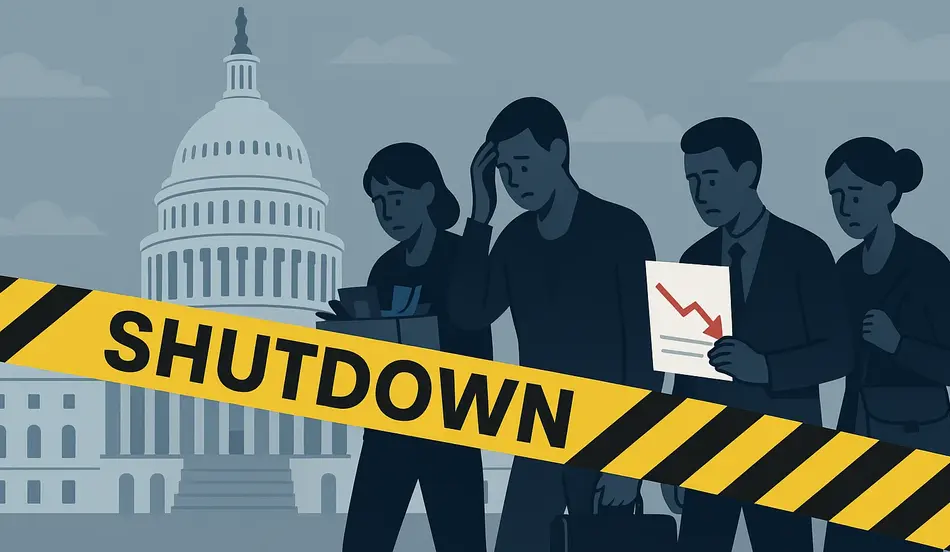Federal workers brace for more mass layoffs as the Trump administration prepares to use a potential government shutdown as an opportunity to permanently eliminate jobs rather than temporarily furlough employees. This unprecedented approach represents a dramatic escalation in the administration’s ongoing effort to reshape and shrink the federal government, creating widespread anxiety and uncertainty among the nation’s 2.1 million federal employees.
The White House Office of Management and Budget has issued guidance advising agencies to develop plans for permanent layoffs instead of traditional furloughs during a shutdown. This policy shift targets any federal employee who doesn’t receive special funding for their job and whose work isn’t focused on Trump administration priorities, potentially affecting large swaths of the federal workforce.
The timing of this announcement, coming just days before a potential government shutdown deadline, has created a perfect storm of uncertainty for federal workers who are already dealing with years of workforce reductions, hiring freezes, and negative rhetoric from the administration. The anxiety is palpable across agencies nationwide, with employees reporting that their workforces are already “trimmed back to the bone” and struggling to carry out essential functions.
This approach represents a fundamental departure from traditional shutdown procedures, where employees are temporarily sent home with the promise of back pay once funding is restored. Instead, the administration is using the shutdown as a tool for permanent workforce reduction, fundamentally changing the nature of government operations and employee job security.
The New Shutdown Strategy: Permanent Layoffs vs. Furloughs
The Trump administration’s new approach to government shutdowns represents a radical departure from established practice. Instead of temporary furloughs where employees are sent home until funding is restored, the administration is now planning to use shutdowns as opportunities for permanent workforce reduction.
This strategy targets employees who don’t receive special funding for their positions and whose work isn’t aligned with administration priorities. The guidance from the Office of Management and Budget specifically focuses on workers funded through normal annual appropriations, potentially affecting hundreds of thousands of federal employees across multiple agencies.
The approach is part of a broader effort to reshape the federal government that began shortly after Trump took office. The administration has already implemented hiring freezes, offered early retirement incentives, and taken other steps to reduce the federal workforce. By the administration’s own estimates, 200,000 to 300,000 federal employees have been removed from the rolls since January 2017.
This new shutdown strategy represents the next phase in this workforce reduction effort, using the threat of permanent job loss as leverage during budget negotiations. The approach creates additional pressure on Congress to reach funding agreements while simultaneously advancing the administration’s goal of a smaller federal government.
The policy shift has created unprecedented uncertainty for federal workers, who can no longer rely on the traditional understanding that shutdowns are temporary inconveniences rather than permanent threats to their employment.
The Scope of Potential Layoffs: Beyond Washington, D.C.
The potential impact of these mass layoffs extends far beyond the Washington, D.C. area, affecting federal workers across the country and around the world. Only 15% of the federal workforce is located in the D.C. area, with the vast majority spread across regional offices, national parks, military installations, and other facilities nationwide.
The Interior Department, which manages national parks and public lands, is already contemplating widespread layoffs that would affect employees in regional offices across the country. The Social Security Administration, Veterans Affairs, and various land management agencies would also be significantly impacted by these cuts.
Environmental Protection Agency enforcement personnel, who work in offices around the country to monitor compliance with environmental regulations, would also be subject to these layoffs. These workers are essential to maintaining environmental protections and ensuring corporate compliance with federal regulations.
The geographic distribution of these layoffs means that the economic impact will be felt in communities across the country, not just in the nation’s capital. Local economies that depend on federal employment will be particularly hard hit, as federal workers typically earn above-average wages and contribute significantly to local tax revenues.
The international impact is also significant, as many federal agencies have employees stationed overseas in embassies, military installations, and other facilities. These workers provide essential services to American citizens abroad and support diplomatic and military operations worldwide.
The Human Cost: Anxiety, Morale, and Job Security
The announcement of potential mass layoffs has created a crisis of confidence among federal workers, many of whom are already dealing with years of workforce reductions and negative rhetoric from the administration. The anxiety is particularly acute because workers can no longer rely on the traditional understanding that shutdowns are temporary.
Federal workers report feeling “attacked” and “villainized” by the administration’s rhetoric and policies. The constant pressure to leave their jobs, combined with the threat of permanent layoffs, has created a toxic work environment that undermines morale and productivity.
The impact on employee morale extends beyond those directly affected by potential layoffs. Even workers in exempted positions report feeling demoralized by the constant threat of job loss and the administration’s apparent hostility toward federal employees.
The psychological toll of this uncertainty is compounded by the fact that many federal workers have dedicated their careers to public service. The prospect of being forced out of jobs they love and believe in is particularly devastating for employees who chose federal service over potentially more lucrative private sector opportunities.
The anxiety is also affecting families and communities, as federal workers face the prospect of losing not just their jobs but their sense of purpose and contribution to society. This uncertainty makes it difficult for workers to plan for the future and provide stability for their families.
The Human Cost of Uncertainty
Mass layoff threats and toxic rhetoric have left federal workers anxious, demoralized, and uncertain about their futures. Employers can offer hope by creating stable, supportive workplaces where employees feel valued and secure. Post your job on WhatJobs today and connect with professionals eager for stability, purpose, and the chance to contribute.
Post a Job Free for 30 Days →The Operational Impact: Agencies Already Struggling
The potential for additional layoffs comes at a time when many federal agencies are already struggling to carry out their essential functions due to previous workforce reductions. Employees report that their agencies are “trimmed back to the bone” and struggling to maintain basic services.
The National Park Service, for example, has already reduced services due to workforce cuts, with bathrooms not being cleaned and certain visitor services no longer being offered. The Forest Service is struggling to keep pace with its responsibilities for managing public lands and preventing wildfires.
The Veterans Affairs Department is experiencing difficulties providing services to veterans, with some employees reporting that they’re unable to provide the level of service that veterans have come to expect. This is particularly concerning given the department’s critical role in supporting those who have served their country.
The Social Security Administration is also struggling to maintain its services, with longer wait times and reduced availability of in-person assistance. This affects millions of Americans who depend on Social Security benefits for their retirement income.
These operational challenges are likely to be exacerbated by additional layoffs, creating a downward spiral where reduced workforce leads to reduced services, which in turn reduces public support for federal agencies and their missions.
The Political Context: Shutdown as a Weapon
The use of shutdowns as a tool for permanent workforce reduction represents a significant escalation in the political battle over the size and scope of the federal government. This approach transforms shutdowns from temporary inconveniences into permanent threats to government operations and employee job security.
The strategy appears designed to create maximum pressure on Congress to reach funding agreements while simultaneously advancing the administration’s goal of a smaller federal government. By threatening permanent job loss, the administration is using federal workers as pawns in a larger political game.
This approach has significant implications for the future of government operations and employee relations. If successful, it could establish a precedent for using shutdowns as tools for workforce reduction, fundamentally changing the nature of federal employment and job security.
The political implications extend beyond the current administration, as future administrations could adopt similar strategies to advance their own policy goals. This could create a cycle of instability that undermines the ability of the federal government to attract and retain qualified employees.
The approach also raises questions about the separation of powers and the role of the executive branch in determining the size and composition of the federal workforce. Traditionally, these decisions have been made through the legislative process, with Congress determining funding levels and the executive branch implementing those decisions.
Frequently Asked Questions
Federal workers brace for more mass layoffs – what’s happening?
Federal workers brace for more mass layoffs as the Trump administration plans to use a government shutdown to permanently fire employees instead of temporary furloughs, targeting workers not aligned with administration priorities.
How is this different from previous government shutdowns?
Unlike previous shutdowns where employees were temporarily furloughed with back pay, the administration now plans to permanently eliminate jobs during shutdowns, fundamentally changing the nature of federal employment security.
Which federal workers are most at risk of layoffs?
Workers most at risk include those funded through normal annual appropriations, employees whose work isn’t focused on Trump administration priorities, and workers in agencies like Interior, EPA, and Social Security Administration.
How many federal workers could be affected by mass layoffs?
The administration has already removed 200,000-300,000 federal employees since 2017, and the new shutdown strategy could affect hundreds of thousands more workers across agencies nationwide, not just in Washington, D.C.
What’s the impact on government services and operations?
Agencies are already struggling with reduced workforces “trimmed back to the bone,” leading to reduced services in national parks, longer wait times at Social Security, and difficulties providing VA services to veterans.
How are federal workers responding to this threat?
Federal workers report feeling “attacked” and “villainized,” with widespread anxiety and panic about permanent job loss, significantly impacting morale and creating a toxic work environment across agencies.
A Real-World Example: The Federal Employee’s Dilemma
Sarah Martinez, a 15-year veteran of the Environmental Protection Agency’s regional office in Denver, faces an uncertain future as the administration prepares for potential mass layoffs. “I’ve dedicated my career to protecting the environment and public health,” she explains. “Now I’m being told that my work isn’t a priority and I could lose my job permanently.”
Sarah’s situation exemplifies the human cost of the administration’s new approach to federal workforce management. As an enforcement officer who monitors compliance with environmental regulations, she represents exactly the type of worker targeted by the new layoff strategy.
“I chose federal service because I wanted to make a difference,” Sarah says. “I could have made more money in the private sector, but I believed in the mission of protecting our environment for future generations. Now I’m being treated like a burden rather than a valuable public servant.”
The uncertainty has taken a significant toll on Sarah and her colleagues. “We’re all walking on eggshells,” she explains. “Every day could be our last, and we don’t know if we’ll be able to provide for our families. It’s not just about the job – it’s about our sense of purpose and contribution to society.”
Sarah’s work has already been affected by previous workforce reductions. “We’re stretched so thin that we can’t keep up with all the violations we need to investigate,” she says. “Companies know we don’t have the resources to monitor them effectively, so they’re more likely to cut corners and violate environmental regulations.”
The prospect of additional layoffs has created a crisis of confidence among Sarah’s team. “People are leaving in droves,” she explains. “The most experienced workers are taking early retirement or finding jobs in the private sector. We’re losing institutional knowledge that can’t be replaced.”
Sarah’s advice to other federal workers reflects the lessons she’s learned. “Don’t take it personally,” she says. “This isn’t about your performance or your value as an employee. It’s about politics and ideology. But that doesn’t make it any easier to deal with the uncertainty and anxiety.”
Sarah’s story demonstrates that the administration’s approach to federal workforce reduction has real human costs that extend far beyond the numbers. The loss of dedicated public servants like Sarah represents a significant loss of expertise and commitment that will be difficult to replace.
Don’t Let Political Games Destroy Public Service
The Trump administration’s plan to use government shutdowns as a tool for permanent workforce reduction represents a dangerous precedent that threatens the stability and effectiveness of the federal government. This approach treats dedicated public servants as political pawns rather than valuable contributors to society.
The key to protecting federal workers and maintaining effective government operations is to recognize that public service is a calling that deserves respect and job security. Federal workers are not the enemy – they’re essential partners in maintaining the services and protections that Americans depend on.
For federal workers facing this uncertainty, the solution is to stay informed about their rights and options, build support networks with colleagues, and consider alternative career paths if necessary. The skills and experience gained in federal service are valuable and transferable to other sectors.
The broader solution requires political leadership that recognizes the value of federal workers and the importance of stable, effective government operations. This means rejecting the use of shutdowns as tools for workforce reduction and instead focusing on constructive approaches to government reform.
The future of federal employment depends on our ability to protect the rights and dignity of public servants while ensuring that government operations remain effective and responsive to the needs of the American people.




